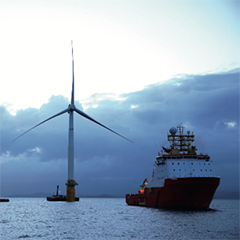Over the past couple of years we have heard more and more about successful floating wind turbine projects. It seems there is huge potential for these floating wind farms. These structures bring with them numerous different security issues. PES brings you an update on the partnership between Orga and Sabik Offshore. It lights up the whole perimeter of the ‘Hywind’ wind farm and makes it visible to both marine vessels and aircraft alike.
A unique wind project off the coast of Scotland
Our oceans, with their vast uninhabited surfaces, have a great potential for creating wind energy. One of the challenges with offshore wind has been that turbines always had to be built on the ocean floor, in relatively shallow waters. This meant that close to 80% of the oceans wind power potential could not be used.
In 2017 the offshore wind farm ‘Hywind’, off the coast of Scotland was opened. The Hywind farm – built by Statoil and Masdar – is the first commercially operational, floating wind farm. It brings us a step closer to unlocking the enormous potential of floating offshore wind parks across our oceans.
A buoy as a source of inspiration
The idea of floating wind turbines, came from a simple buoy that a Statoil engineer passed on an afternoon of sailing with his colleague. The engineers recognised the value of the idea. Later that day they started sketching in the canteen, on the back of a napkin.
The wind farm consists of 5 Siemens turbines that have a total capacity of 30MW. The turbines are subjected to winds of 10 meter per second and waves with an average height of 1.8 metres.
The design of the floating turbines is based on a single floating cylindrical spar buoy. The construction is chained to the sea bed with chains or cables. To make sure the turbine is balanced and floats upright, it is ballasted with three 60 tonne weights.
Software aboard each turbine monitors the winds and waves and alters the pitch of the blades. This dampens the motion of the turbine and maximises production.
The most challenging aspect was to make the wind farm last for 20 years in these extreme circumstances. The stresses on the big constructions are enormous. The Hywind concept was successfully tested on a full scale prototype located off the coast of Karmøy, Norway and was then optimised for the Hywind pilot park.




























